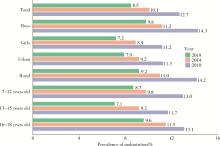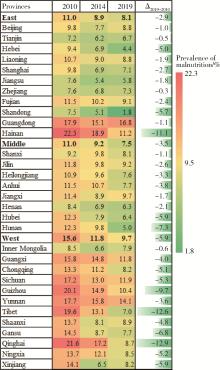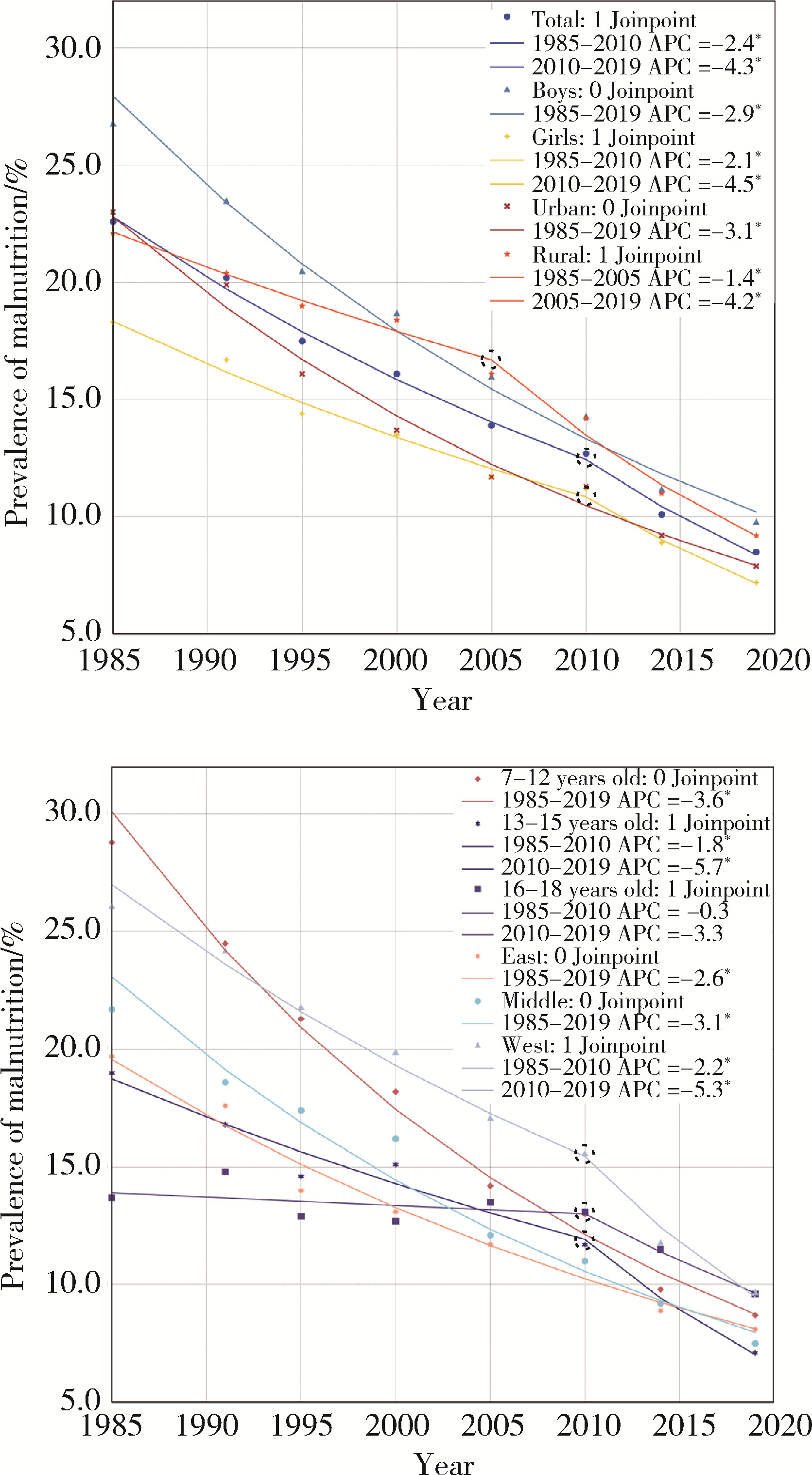北京大学学报(医学版) ›› 2023, Vol. 55 ›› Issue (4): 593-599. doi: 10.19723/j.issn.1671-167X.2023.04.004
《中国儿童发展纲要(2011-2020年)》实施期间中小学生营养不良率变化及其政策效应分析
闫晓晋,刘云飞,马宁,党佳佳,张京舒,钟盼亮,胡佩瑾,宋逸*( ),马军
),马军
- 北京大学公共卫生学院,北京大学儿童青少年卫生研究所,北京 100191
Assessment of prevalence of malnutrition among Chinese primary and secondary school students and analysis of policy effect during the period of the Program for the Development of Chinese Children 2011-2020
Xiao-jin YAN,Yun-fei LIU,Ning MA,Jia-jia DANG,Jing-shu ZHANG,Pan-liang ZHONG,Pei-jin HU,Yi SONG*( ),Jun MA
),Jun MA
- Institute of Child and Adolescent Health, Peking University School of Public Health, Beijing 100191, China
摘要:
目的: 评估《中国儿童发展纲要(2011—2020年)》(简称2011儿纲)实施期间中小学生营养不良率的变化情况及其政策效应。方法: 利用1985—2019年8次全国学生体质与健康调研中7~18岁学生的数据,依据《学龄儿童青少年营养不良筛査》判断学生营养不良情况,按性别、城乡、年龄组、省份分层描述中小学生营养不良率在2010—2019年期间的变化情况。利用Joinpoint回归模型对1985—2019年7~18岁学生营养不良率的变化轨迹进行分析,从而评价2011儿纲的政策效应。结果: 2010—2019年,中国中小学生营养不良率由12.7%下降到8.5%,男女生、城乡学生及各年龄组学生的营养不良率均呈现持续下降趋势(P趋势均 < 0.001)。2010—2019年,31个省(自治区、直辖市)中有27个省份中小学生营养不良率显著下降。Joinpoint回归模型结果显示,1985—2019年,中国中小学生营养不良率持续下降,2010年为下降趋势中的拐点。1985—2010年,中小学生营养不良率平均每年下降2.4%(95%CI: 1.9%~2.8%,P < 0.001),2010年以后下降趋势加快,平均每年下降4.3%(95%CI: 2.4%~6.2%,P < 0.001)。结论: 2010—2019年,中国中小学生营养不良率持续下降,实现了2011儿纲中控制营养不良率的目标。2011儿纲的发布可能对于改善中小学生营养不良问题起到了重要的作用,然而目前中小学生营养不良问题仍然存在,仍需加大对于营养不良高发地区的营养改善计划的覆盖范围和财政支持力度。
中图分类号:
- R153.2
| 1 | Young EM . Food and development[M]. Abingdon, Oxon: Routledge, 2013: 36- 38. |
| 2 | United Nations International Children ' s Emergency Fund . The State of the World's Children 2019: Children, food and nutrition: Growing well in a changing world[M]. New York: UNICEF, 2010: 61- 75. |
| 3 | United Nations International Children ' s Emergency Fund. The State of the World's Children 2019: Children, food and nutrition: Growing well in a changing world[R]. New York: UNICEF, 2019. |
| 4 | Akparibo R , Harris J , Blank L , et al. Severe acute malnutrition in children aged under 5 years can be successfully managed in a non-emergency routine community healthcare setting in Ghana[J]. Matern Child Nutr, 2017, 13 (4): e12417. |
| 5 |
Harold A , John H , Bill K . Long term consequences of early childhood malnutrition[J]. Oxford Econ Pap, 2006, 58 (3): 450- 474.
doi: 10.1093/oep/gpl008 |
| 6 |
Black RE , Victora CG , Walker SP , et al. Maternal and child undernutrition and overweight in low-income and middle-income countries[J]. Lancet, 2013, 382 (9890): 427- 451.
doi: 10.1016/S0140-6736(13)60937-X |
| 7 |
NCD Risk Factor Collaboration . Worldwide trends in body-mass index, underweight, overweight, and obesity from 1975 to 2016: A pooled analysis of 2 416 population-based measurement studies in 1 289 million children, adolescents, and adults[J]. Lancet, 2017, 390 (10113): 2627- 2642.
doi: 10.1016/S0140-6736(17)32129-3 |
| 8 | 中华人民共和国国务院. 中国儿童发展纲要(2011—2020年)[EB/OL]. (2011-07-30)[2021-01-05]. https://www.scio.gov.cn/ztk/xwfb/46/11/Document/976030/976030.htm. |
| 9 | 中国学生体质健康调研组. 1985年中国学生体质与健康研究[M]. 北京: 人民教育出版社, 1987: 4- 6. |
| 10 | 中国学生体质健康研究组. 1995年中国学生体质与健康调研报告[M]. 长春: 吉林科学技术出版社, 1997: 3- 4. |
| 11 | 中国学生体质健康研究组. 2000年中国学生体质与健康调研报告[M]. 北京: 高等教育出版社, 2002: 3- 4. |
| 12 | 中国学生体质健康研究组. 2005年中国学生体质与健康调研报告[M]. 北京: 高等教育出版社, 2007: 8- 9. |
| 13 | 中国学生体质健康研究组. 2010年中国学生体质与健康调研报告[M]. 北京: 高等教育出版社, 2012: 4- 5. |
| 14 | 中国学生体质健康研究组. 2014年中国学生体质与健康调研报告[M]. 北京: 高等教育出版社, 2016: 4- 5. |
| 15 | 中国学生体质与健康研究. 中国学生体质与健康监测报告(1991年)[M]. 北京: 科学技术出版社, 1993: 2- 3. |
| 16 | 国家卫生和计划生育委员会. WS/T 456—2014学龄儿童青少年营养不良筛查[S]. 北京: 中国标准出版社, 2014. |
| 17 | 赵志强, 叶蜀君. 东中西部地区差距的人类发展指数估计[J]. 华东经济管理, 2005, 19 (12): 22- 25. |
| 18 |
Kim HJ , Fay MP , Feuer EJ , et al. Permutation tests for joinpoint regression with applications to cancer rates[J]. Stat Med, 2000, 19 (3): 335- 351.
doi: 10.1002/(SICI)1097-0258(20000215)19:3<335::AID-SIM336>3.0.CO;2-Z |
| 19 | 李辉章, 杜灵彬. Joinpoint回归模型在肿瘤流行病学时间趋势分析中的应用[J]. 中华预防医学杂志, 2020, 54 (8): 908- 912. |
| 20 | 中华人民共和国国务院. 九十年代中国儿童发展规划纲要[EB/OL]. (1992-02-16)[2021-01-05]. http://www.wsic.ac.cn/policyandregulation/7666.htm. |
| 21 | 中华人民共和国国务院. 中国儿童发展纲要(2001—2010年)[EB/OL]. (2001-05-22)[2021-01-05]. http://www.scio.gov.cn/xwfbh/xwbfbh/wqfbh/39595/41756/ xgzc41762/Document/ 1664775/1664775.htm. |
| 22 |
Zong XN , Li H , Zhang YQ , et al. Child nutrition to new stage in China: Evidence from a series of national surveys, 1985-2015[J]. BMC Public Health, 2019, 19 (1): 402.
doi: 10.1186/s12889-019-6699-z |
| 23 | 季成叶. 中国乡村学生群体营养不良流行状况20年动态分析[J]. 中国儿童保健杂志, 2009, 17 (1): 11- 14. |
| 24 | 房玥晖, 赵丽云, 于冬梅, 等. 2010—2012年中国6~17岁儿童青少年生长迟缓和消瘦状况[J]. 卫生研究, 2018, 47 (1): 27- 31. |
| 25 | 董彦会, 王政和, 马军. 2005—2010年我国7~12岁学生营养不良流行现状分析[J]. 营养学报, 2016, 38 (5): 431- 437. |
| 26 | 中华人民共和国国务院. 国务院办公厅关于实施农村义务教育学生营养改善计划的意见[EB/OL]. (2011-11-23)[2021- 01-05]. http://www.yueyang.gov.cn/mlzfw/25310/27768/27769/content_638768.html. |
| 27 | 普布卓玛, 索朗卓玛, 李素娟, 等. 西藏2015—2017年农村中小学生营养改善状况评估[J]. 中国学校卫生, 2020, 41 (1): 29-31, 35 |
| 28 | 余闯. 营养改善计划惠及全国3700万农村学生[N/OL]. 中国教育报, (2018-07-04)[2021-01-19]. http://www.moe.gov.cn/jyb_xwfb/xw_zt/moe_357/jyzt_2018n/2018_zt11/zt1811_gz/zt181107_mtgz/201807/t20180704_341921.html. |
| [1] | 李成跃, 王浩, 阿力木江·依米提·塔尔肯. 1985——2019年新疆维吾尔族中小学生生长发育的长期趋势[J]. 北京大学学报(医学版), 2024, 56(5): 802-808. |
| [2] | 张祖洪,陈天娇,马军. 中小学生青春发动时相与心血管代谢危险因素的相关性[J]. 北京大学学报(医学版), 2024, 56(3): 418-423. |
| [3] | 黄冰, 王洪源. 全球新型冠状病毒肺炎疫情发展趋势及严重程度[J]. 北京大学学报(医学版), 2021, 53(3): 536-542. |
| [4] | 段丽萍,郑朝霞,张宇慧,董捷. 腹膜透析患者营养不良-炎症-心血管疾病与认知功能恶化的关系[J]. 北京大学学报(医学版), 2019, 51(3): 510-518. |
| [5] | 陈瑶,张晓辉,许兰平,刘开彦,秦炯,杨艳玲,黄晓军. 单倍体相合异基因造血干细胞移植治疗肾上腺脑白质营养不良[J]. 北京大学学报(医学版), 2019, 51(3): 409-413. |
| [6] | 董彦会,王政和,杨招庚,王西婕,陈妍君,邹志勇,马军. 2005年至2014年中国7~18岁儿童青少年营养不良流行现状及趋势变化分析[J]. 北京大学学报(医学版), 2017, 49(3): 424-432. |
| [7] | 满塞丽麦,郭岩△. 中国5岁以下儿童营养不良的社会决定因素研究[J]. 北京大学学报(医学版), 2016, 48(3): 418-423. |
| [8] | 宋逸, 胡佩瑾, 张冰, 马军. 1985年至2010年中国18个少数民族17岁学生身高趋势分析[J]. 北京大学学报(医学版), 2015, 47(3): 414-419. |
| [9] | 姜毅, 侯新琳, 李昕, 林志淼, 崔晨. 新生儿遗传性营养不良性大疱性表皮松解症基因诊断1例[J]. 北京大学学报(医学版), 2013, 45(2): 202-. |
| [10] | 冯星淋, 杨青, 徐玲, 王燕, 郭岩 . 中国实现联合国千年发展目标5的进程和挑战(英文稿)[J]. 北京大学学报(医学版), 2011, 43(3): 391-396. |
| [11] | 张艳芝, 熊晖, 王小竹, 王硕, 罗静, 王静敏, 姜玉武, 常杏芝, 潘虹, 齐建光, 李万镇, 袁云, 吴希如. 假肥大型进行性肌营养不良患者的基因型、表型分析及随访研究[J]. 北京大学学报(医学版), 2010, 42(6): 661-666. |
| [12] | 李翔, 张巍, 吕鹤, 王朝霞, 袁云. 强直性肌营养不良骨骼肌Akt通路活性与病理改变的相关性分析[J]. 北京大学学报(医学版), 2010, 42(5): 526-529. |
| [13] | 郭应禄. 泌尿外科发展战略构想[J]. 北京大学学报(医学版), 2010, 42(4): 363-365. |
| [14] | 平莉莉, 包新华, 王爱花, 潘虹, 吴晔, 熊晖, 张月华, 秦炯, 吴希如. 40例X连锁肾上腺脑白质营养不良患者的基因型与表型[J]. 北京大学学报(医学版), 2006, 38(1): 66-70. |
| [15] | 黎青, 李少英, 胡冬贵, 孙筱放, 陈敦金, 张成, 蒋玮莹. 假肥大型肌营养不良症的产前基因诊断[J]. 北京大学学报(医学版), 2006, 38(1): 53-56. |
|
||






